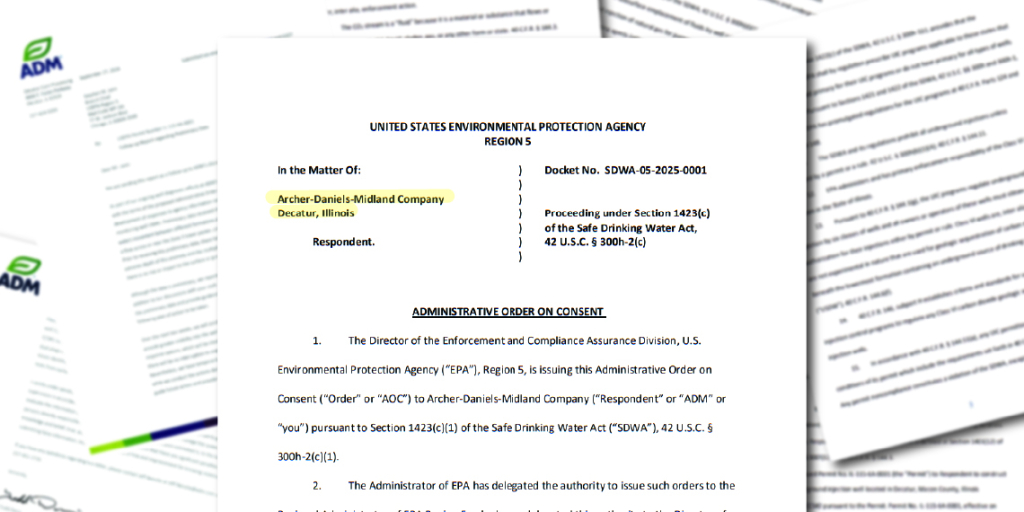
Last week, company identified ‘anomaly’ in monitoring well
By ANDREW ADAMS
Capitol News Illinois
[email protected]
After identifying an underground carbon dioxide leak earlier this year, agribusiness giant ADM found a further “anomaly” in one of the wells at its Decatur carbon dioxide sequestration plant last week.
ADM has temporarily paused carbon dioxide injections as it conducts additional testing, according to company spokesperson Jackie Anderson.
Carbon sequestration, an emerging technology that pumps liquified carbon dioxide deep underground for long-term storage, is hailed by some as a way to reduce greenhouse gas emissions from high-emission industries like soy processing. But others view the practice as more dangerous than beneficial.
As part of the company’s “ongoing diagnostic efforts,” it found evidence of brine – salty water – moving between the underground rock formations it uses for carbon dioxide storage, according to a letter from ADM to the U.S. Environmental Protection Agency.
This creates the potential for other underground material to escape its containment zones, although the company’s letter said it has not collected any data indicating that has happened.
“There is no impact to the surface or groundwater sources, nor any threat to public health,” Anderson said in an email statement. “We notified the U.S. EPA about this matter, and we’re conducting additional diagnostic tests in consultation with U.S. EPA and external experts. We will share additional information as we learn more.”
The company was already under the close watch of federal regulators after the EPA alleged ADM violated federal law in its handling of a leak of carbon dioxide earlier this year.
Read more: ADM carbon sequestration project violated Safe Drinking Water Act, per EPA
That leak resulted in 8,000 metric tons of liquid carbon dioxide escaping the underground rock formation where it was supposed to be stored. That liquified carbon dioxide remains underground and the EPA says nothing so far has suggested there is a threat to drinking water in the area.
But, on its website, the EPA notes that public water systems have been advised to monitor water for taste and odor.
That event has also resulted in a proposed consent order which would require ADM to take new measures to comply with both its EPA permit and federal law. These measures include expanded monitoring and taking new actions to address any fluids that have migrated.
The EPA is now accepting public comments on the matter through Oct. 21 before potentially issuing a binding order.
The situation has sparked renewed calls for tighter restrictions on carbon capture projects in the state, and particularly in this part of central Illinois.
After lawmakers in Springfield passed legislation instituting new regulations for carbon capture and sequestration projects, some said they didn’t go far enough in protecting the Mahomet Aquifer – the drinking water source for many in the region.
Read more: Lawmakers move to pause – then further regulate – carbon dioxide pipeline development
ADM’s project is largely exempted from the new regulations and Decatur sits south of the aquifer, but environmental activists say the leak should act as a wake-up call.
Rep. Carol Ammons, D-Urbana, filed legislation last month to ban carbon sequestration development that “overlies, underlies, or passes through” an aquifer that is the sole-source of drinking water for a community.
“The leaks at ADM’s facility should serve as a red flag to lawmakers,” Pam Richart, co-director of Eco-Justice Collaborative and supporter of the recent legislation, said. “We can’t afford to wait for a disaster. Legislators need to act now and pass the ban on carbon sequestration beneath the Mahomet Aquifer.”
That legislation could be considered as early as November, when lawmakers are scheduled to return to Springfield before next year’s spring session begins in January.
Capitol News Illinois is a nonprofit, nonpartisan news service that distributes state government coverage to hundreds of news outlets statewide. It is funded primarily by the Illinois Press Foundation and the Robert R. McCormick Foundation.






